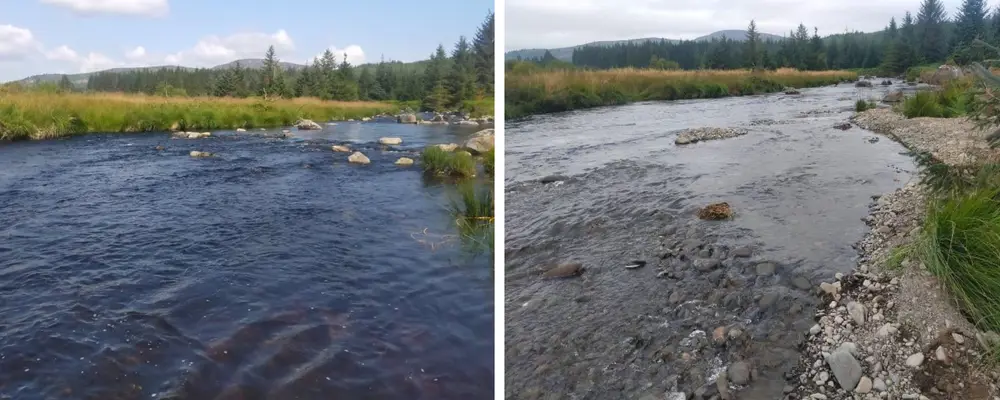New project helping to support fish populations in Galloway Forest Park
This partner-run project is thought to be the first of its kind in Scotland. Through a series of environmental restoration tasks, the project's goal is to restore the Black Water of Dee to be more favourable for salmon and trout.

The lower secton of the Black Water of Dee river in Galloway runs from below the Hydro-Electric dam at Clatteringshaws, by the Raider's Road Forest Drive and Otter Pool Visitor Facility, joining Loch Ken opposite Parton.
In 2012, the compensation water flows in the river were increased and the lower Pullaugh Burn reconnected to the river. A study in 2016 identified that there were still a range of factors limiting the population of trout and salmon in the Black Water of Dee, including the habitat along the riverbanks and the lack of spawning substrate in the river.
The Black Water of Dee Habitat restoration project kicks off in 2021:
Current situation: river channel empty of smaller spawning substrate and river bank tree cover not particularly good habitat for salmon and trout.
Addition of substrate: 450 tonnes of smaller gravels etc. from elsewhere in the catchment introduced at sacrificial sites to be washed into the river at times of high flow.
Riverbank work: encroaching naturally seeded conifers are mapped; targeted removal and native trees being planted.
Result: a more natural river environment is created providing improved habitat and spawning opportunities for fish.
To get in touch, contact Rowan McCleary at Galloway Fisheries Trust: rowan@gallowayfisheriestrust.org
The project started after a study showed the site has great potential for migratory fish, such as salmon and trout. However, Galloway Fisheries Trust (the founders of the project) found very few fish present while surveying the water.
Some of the issues noted include the creation of a hydroelectric dam further upstream, which is washing away gravel beds needed for spawning fish. Non-native conifer trees are also growing too close to the riverbank. This causes a few problems. The first is that conifers don't provide the same nutrients to the water as broadleaves do. The second issue is they can cast too much shade and cause bankside erosion.
These stressors are impacting the population of both these important species, and lead to this exciting partnership project formed along the Black Water of Dee.

How the habitat is being restored
There are many things we can do to restore freshwater fish populations in Scotland. Even small changes can really make a huge difference in creating better habitats for aquatic life, for example planting broadleaf trees provides dappled shade, nutrients and protects the riverbanks.
This project is focusing on three areas of restoration;
- Building up the riverbed: adding additional gravel (around 450 tonnes) to the site will help increase the available spawning habitat for the fish.
- Removing conifers from the riverbank: this will help lower the acidification level in the river and help create better water quality for the salmon and their eggs.
- Planting native trees along the riverbank: planting native broadleaf trees along the riverbank will provide dappled shade (which will help keep the water cool) and provide nutrients back into the water when the leaves fall.
Why are salmon important
“Salmon are nationally one of our priority species for conservation.
The project has taken many years of hard planning by all the partners. As the land owner, being given the opportunity to collaborate in the Black Water of Dee project has helped us to better understand the local issues affecting salmon populations. This is key for the survival of the species.
In the long term not only will this project help the local salmon population but it has also created a stepping stone for future restoration projects of this scale on a national level.”
Kim Kirkbride, Environment Forester at Forestry & Land Scotland

Having healthy populations of salmon is important to rivers and burns because they help move nutrients between the sea and the freshwater ecosystem where they spawn. Often these smaller bodies of water have lower levels of nutrients, so this can really benefit the overall biodiversity.
We’re now seeing higher water temperatures in Scotland, most likely due to climate change and a lack of broadleaf trees and scrub along the riverbanks. Research shows that it’s likely getting too warm for the salmon eggs and young salmon to survive in. Planting native trees along the riverbanks provides shades the water, reducing the increasing water temperatures during summer and making the habitat better for the young salmon.
Where you can see the project in action